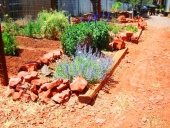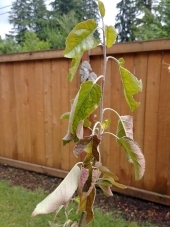It looks like you might have two different things going on. The first picture looks like leaf-cutter. They burrow under the surface of the leaf and leave their telltale tunnels behind.
That second picture looks like white fly.
For leaf-cutter, I haven't found a solution, other than plant a diversity of other beneficial plants all around it and encourage the development of a community of beneficial insects that will eat them. I used to get them bad on my citrus trees, but not so much at all anymore because there are so many spiders, ladybugs, wasps, preying mantus, etc.
For white fly, just blast the crap out of them with the garden hose. Do it daily for a week or so until they've all been killed, dislodged, inconvenienced and have vacated the location. I used to spray (way back in the day), but again, once you establish an environment where beneficial insects make their home, you don't want to do that. I haven't sprayed in 14 years. I haven't seen whitefly in 12.
1. Plant a wide variety of stuff throughout your orchard. Comfrey, veggies, flowers . . . the more species the better. Let them go to seed and leave them throughout the winter.
2. Don't keep things so clean that there isn't any place for insects to overwinter. However, that does not apply to fallen fruit (where codling moths breed) or to suckers on the base of your apple trees (where white fungus will build up).
3. Don't spray anything other than a garden hose. Even organic all-natural sprays will kill the beneficial insects you are trying to encourage.
4. When you eventually clean things up, do it a little bit at a time, and quickly replant new stuff so that there is always a broad diversity of stuff growing (or dying) throughout the garden/orchard. If there is a way to clean things up but leave the pile of dead plant material laying over to the side, you'll still provide shelter and food. I like the look of a clean garden, but I'm learning to pile stuff up and let it
compost in place, rather than haul off everything, including the insect eggs that may be growing on the underside of dying plants.
Best of luck.











